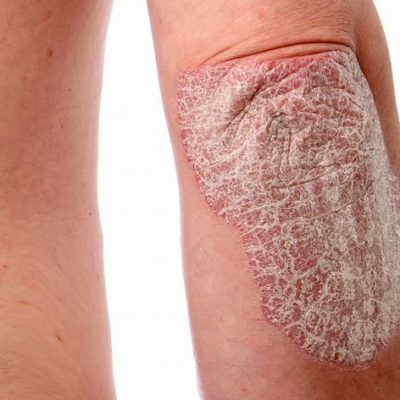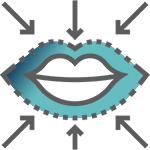Psoriasis
Psoriasis
It occurs equally in men and women, at any age, and tends to come and go unpredictably. It is not infectious, and does not scar the skin. It can last between months to years and it is characterized by red plaques with scale that can appear anywhere in the body but mainly scalp, elbows and knees.

What causes psoriasis?
The skin is a complex organ made up of several different layers. The outer layer of skin (the epidermis) contains cells which are formed at the bottom and then move up towards the surface, gradually changing as they go, finally dying before they are shed from the surface. This process normally takes between 3 and 4 weeks. In psoriasis, the rate of turnover is dramatically increased within the affected skin, so that cells are formed and shed in as little as 3 or 4 days. There is also inflammation and blood vessel proliferation on the affected skin; the reasons for these are still not fully understood. There is activation of the immune cells in the skin causing inflammation. Some people are more likely to develop psoriasis than others, particularly if there is someone else in their family who has psoriasis: in other words, it is a genetic or hereditary disease. However, the trigger for psoriasis to appear is often an outside event, such as a throat infection, stress or an injury to the skin. In practice, for most patients who develop psoriasis, or for whom it clears and then comes back, no obvious cause can be detected. Usually, sunlight improves psoriasis, though occasionally it makes it worse (especially if the skin gets burned). A high alcohol intake and smoking can worsen psoriasis too, as can medicines used for other conditions – such as lithium, some tablets used to treat malaria (e.g. hydroxychloroquine), and other drugs such as beta blockers (medicines commonly used to treat angina and high blood pressure). There might be a relationship between diet and psoriasis, but is still not fully understood, in general we advise avoiding pro inflammatory foods, alcohol and caffeine
Is psoriasis hereditary?
Yes, but the way it is inherited is complex and not yet fully understood. Many genes are involved, and even if the right combination of genes has been inherited psoriasis may not appear. Other features of the inheritance of psoriasis are: There is more likely to be a family history of psoriasis in people who get it when they are young than in those who develop it when they are older. A child with one parent with psoriasis has roughly a 1 in 4 chance of developing psoriasis. If one of a pair of twins has psoriasis, the other twin has a 70% chance of having it too if the twins are identical, but only a 20% chance if not identical.
What are the symptoms of psoriasis?
The main problem with psoriasis for many people lies in the way it looks. This can affect their quality of life.
Psoriasis can itch and the affected skin can split, which may be painful.
Some people with psoriasis may develop stiff and painful joints, which can be due to a form of arthritis associated with psoriasis called psoriatic arthritis. The joints most commonly affected are the fingers, toes, wrists, knees and ankles.
What does psoriasis look like?
Lesions of psoriasis (often known as plaques) are pink or red, and covered with silvery-white scales. They can form a variety of shapes and sizes, and have well-defined boundaries with the surrounding skin. Some arise where the skin has been damaged, for instance by a cut or a scratch, and this is known as the Köbner phenomenon. On the scalp, the scales heap up so that the underlying redness is hard to see. In contrast, in body folds such as the armpits and groin, the red well-defined areas are easy to see but are seldom scaly.
The severity of psoriasis varies with time, and from person to person. When it is mild, there may be only one or two plaques, whilst when it is more severe there may be large numbers.
The plaques can take up a variety of patterns on the skin:
The most common pattern is chronic stable plaque psoriasis. The persistent plaques tend to appear symmetrically, most often on the knees, elbows, trunk and scalp, though any area can be involved.
Guttate psoriasis is another variant. It is seen most often in children and is sometimes triggered by a sore throat. The patches of guttate psoriasis are usually small (often less than 1 cm in diameter), but numerous.
In unstable psoriasis, the plaques of psoriasis lose their clear-cut sharp edges, enlarge, and sometimes join up. New ones may appear too. Occasionally the skin becomes red all over; this condition is known as erythrodermic psoriasis. Unstable psoriasis must be treated with bland preparations as stronger ones can make it worse.
There are two main types of pustular psoriasis. The first, and most common, involves only the palms and soles (palmo-plantar pustulosis), where the red areas contain a mixture of new yellow pustules (containing pus) and older brown dried-up pustules. This type is slow to clear and often responds poorly to treatment. A different, unrelated, and more widespread (generalized) type of pustular psoriasis can affect any part of the skin, and is more severe.
Changes in the nails can often be seen too, if looked for carefully. They appear in up to 50% of people with psoriasis. The most striking ones are:
- Irregular pitting (indentations) of the surface of the nail
- Circular areas of discoloration under the nail
- Separation of the nail from the underlying nail bed
- Thickening of the nails
Can psoriasis be cured?
No. However, treatment to control the signs and symptoms is usually effective. The skin becomes less scaly and may then look completely normal. However, even if your psoriasis disappears after treatment, there is a tendency for it to return. This may not happen for many years, but can do so within a few weeks.
How can psoriasis be treated?
This will depend on the type of psoriasis that you have, and on its severity. Treatments that are applied directly to the skin are known as topical therapies. They include creams, ointments, pastes and lotions. If your psoriasis is mild, topical therapies will be the mainstay of your treatment. Topical treatments include the following: Emollients (moisturizers), topical steroids, tar preparations, Vitamin D analogues, Vitamin A analogues, Topical immunosuppressant medications, also called calcineurin inhibitors.
In cases, where the disease is very extensive or severe, patients may need oral treatment or phototherapy; however all of the different tablets have potential risks. In addition, you will usually have to continue with some topical therapy even though you are taking the tablets.
Your dermatologist will discuss the risks with you if you start on this kind of treatment. All of the tablets will require blood tests, and many interfere with other medicines. Female patients should not become pregnant whilst on any tablets for psoriasis, and with some of them it is important that male patients should not father a child.
The oral treatments include Acitretin (related to vitamin A), cyclosporine (suppresses the immune system), and methotrexate (slows down the rate at which the skin cells are dividing in psoriasis). There are also several injectable forms of treatments available for severe forms of psoriasis. The biologic medications, that target more specific components of the defense system, include adalimumab, ustekinumab, etanercept and infliximab.
Self-care (What can I do?)
- It helps to educate those around you about psoriasis. A simple explanation will often turn their misconceptions into support. Make sure they know that it is not infectious.
- If possible, cut down your smoking and consumption of alcohol.
- Consider contacting others who have psoriasis through a support group.
- Stress management may be helpful.
- Always use the treatments prescribed for you.
- In the last few years, there are a number of research papers that point to the fact that there is a higher risk of heart disease, diabetes and obesity in people with psoriasis therefore it is advisable to take regular exercise, have a healthy diet and keep an eye on your blood pressure.


Monica
Padilla
NURSE GRADUATED FROM CUC
CERTIFICATE PROGRAM IN WOUND HEALING
STAFF

Betsy
Aguirre
RECEPTION AND SALES
STAFF


Marisol
San Rafael
CERTIFIED COSMETOLOGIST
STAFF


Esmeralda
Alcaraz
CERTIFIED COSMETOLOGIST
STAFF


Lolita
Simental
RECEPTION AND SALES
STAFF

Creation
Proin at varius arcu. Sed posuere orci bibendum pharetra dapibus.

Analyses
Proin at varius arcu. Sed posuere orci bibendum pharetra dapibus.

Marketing
Proin at varius arcu. Sed posuere orci bibendum pharetra dapibus.
Choose the perfect product for you
ADDRESS
Derma Health Av. Los Tules 158, Col. Díaz Ordaz Puerto Vallarta
SCHEDULE
- Mon-Fri 9:00 am a 20:00 pm
- Saturday 9:00 am a 14:00 pm
- Sunday closed
- Copyright 2023. All rights reserved.